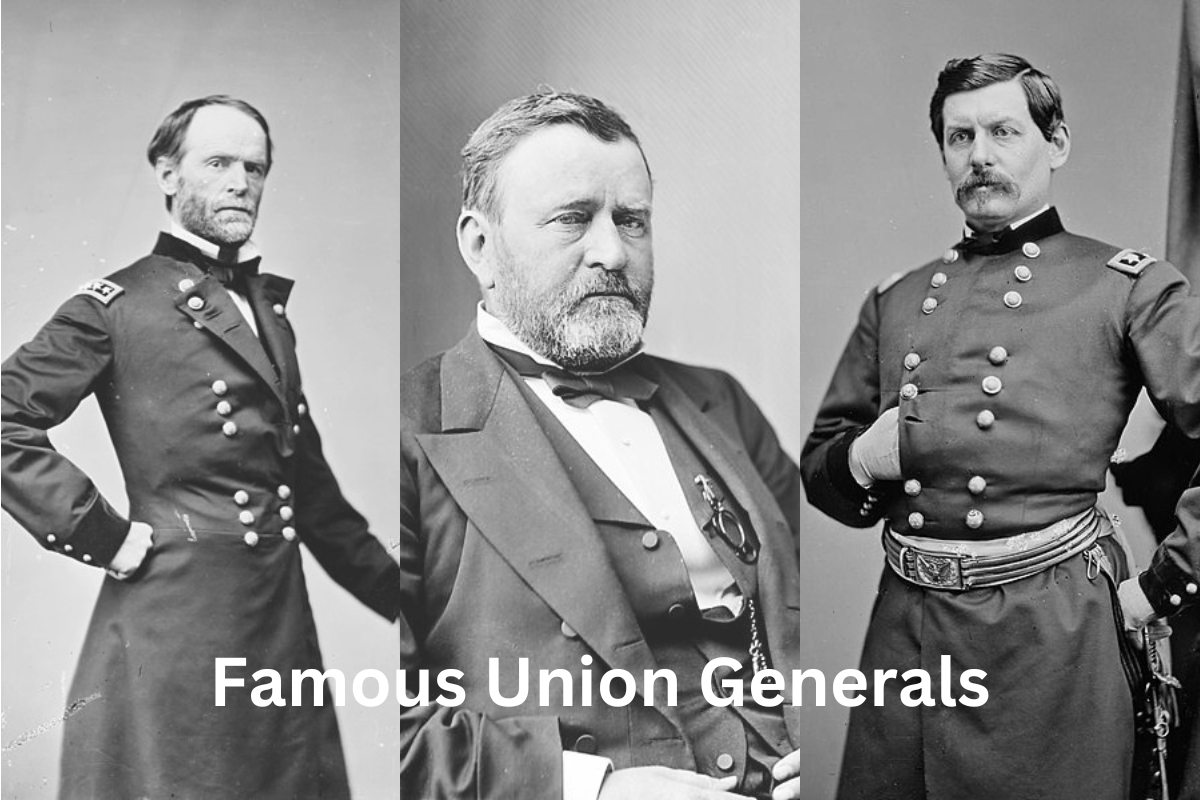The Union Army, also known as the Federal Army and the Northern Army, referred to the United States Army, the ground army that fought during the American Civil War to maintain the Union of the states.
The Union Army’s commissioned officers had ranks ranging from Lieutenant General (a position added on March 2, 1864) to Major General and Brigadier General, as well as those of Colonel, Lieutenant Colonel, and Major in the field, and Captain, First Lieutenant, and Second Lieutenant in the company.
3 Types of Generals in the Union Army
1. Lieutenant General
Until an act of Congress was passed in February 1864, the rank of lieutenant general did not exist in the Union Army. Under the guidance and at the leisure of the President, a single lieutenant general was given the authority to lead all field armies and geographic districts of the United States.
They were legally permitted to have a chief of staff at the brigadier general rank, as well as two secretaries and four aides-de-camp at the lieutenant colonel level.
Given the scarcity of more senior general commanders, divisions were sometimes delegated to the leadership of a major general, who also served as the head of an army corps, field army, or geographic department.
2. Major General
A major general could have up to three aides-de-camp working for him directly. Separate from the general staff of the unit he led, the general would bring along a select group of captains and lieutenants from the Army whenever he changed command.
3. Brigadier General
A brigadier general oversaw a group of soldiers known as a brigade, but like major generals, they sometimes oversaw bigger formations. Especially while acting alone, it was their responsibility to organize and administer their command.
In the same way as major generals are given two lieutenant aides-de-camp, these officers were also given a personal staff of their own.
Famous Union Generals
1. Ulysses S. Grant

Ulysses S. Grant (April 27, 1822 – July 23, 1885) was the 18th president of the United States and a prominent military figure and politician. During the years 1869-1877, he served as president.
He was the Union Army’s commanding general in 1865, when the Union won the Civil War. After that, he was appointed Secretary of War.
Later in his presidency, Grant emerged as a strong leader on civil rights issues, sponsoring legislation that established the Justice Department and working with Radical Republican allies to safeguard African Americans during Reconstruction.
Also Read: Confederate vs Union
Incredibly, Grant, who was born in Ohio, had an extraordinary talent for working with horses. Accepted to West Point, Grant graduated 21st in his class and went on to serve with distinction in the Mexican-American War.
He married Julia Dent in 1848, and the pair had four children together. In 1854, Grant left the service and returned home to his family, despite the fact that he was now financially struggling.
When the American Civil War broke out in 1861, he joined the Union Army and soon became a prominent figure as he led the Union to a series of victories in the Western theater.
He spearheaded the effort to capture Vicksburg, Mississippi, in 1863, ultimately splitting the Confederacy in two. After his triumph at Chattanooga, President Abraham Lincoln promoted him to lieutenant general.
Also Read: Famous Confederate Generals
Grant and Robert E. Lee fought for a total of thirteen months, during which time they engaged in the deadly Overland Campaign and the siege of Petersburg. In the aftermath of Lee’s retreat from Petersburg, Grant handily overcame his opponent at Appomattox. When Lee officially handed up the South to Grant on April 9, 1865, the Civil War ended.
Andrew Johnson, who became office a week after Lincoln was killed, appointed Grant to general. A public conflict ensued between Grant and Johnson over Reconstruction policy, and Grant used the Reconstruction Acts, which were approved over Johnson’s veto, to insure that newly freed African Americans were given their constitutionally promised civil rights.
Also Read: Ulysses S Grant Facts
The Republican Party nominated Grant for president in 1868, and he went on to win the election and become president thanks to his heroic record in battle and his strong moral compass.
Grant’s presidency was notable for his work to restore the economy in the wake of the war, his advocacy for Congressional Reconstruction and the 15th Amendment, and his dogged pursuit of the elimination of the Ku Klux Klan.
Grant had a crucial role in revitalizing the Union’s military. He appointed African-Americans and Jews alike to high government positions.
2. George McClellan
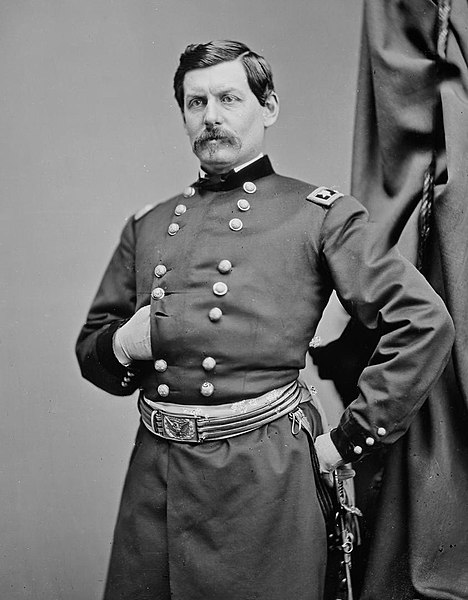
Beginning on December 3, 1826, until his death on October 29, 1885, George Brinton McClellan served as the 24th governor of New Jersey and as an American soldier. Besides being a politician, he also served as a railroad executive and civil engineer.
After making his mark in the Mexican-American War (1846–1848), West Point graduate McClellan served as a railroad executive and engineer until the outbreak of the American Civil War (1861–1865).
McClellan was the Union Army’s commanding general for only three months (November 1861–March 1862) yet he had a crucial role in the formation of the Eastern Theater’s Army of the Potomac during his time as major general.
General McClellan and President Abraham Lincoln had grown mutually suspicious of one another, and McClellan was insulting Lincoln behind the president’s back. McClellan lost his position as commander in November 1862, after the midterm elections.
The Union’s strategic but inconclusive win at the Battle of Antietam near Sharpsburg, Maryland, impacted McClellan’s decision not to follow Lee’s army.
McClellan ran for president in 1864 after being removed from his field command, but he was soundly defeated by Republican Abraham Lincoln.
His campaign was hampered when he rejected his party’s platform, which advocated for a peace settlement with the Confederacy and an end to the war. He served as the 24th Governor of New Jersey from 1878 to 1881. He took up writing in his later years, using it to vigorously justify his behavior during the Civil War.
3. William Tecumseh Sherman
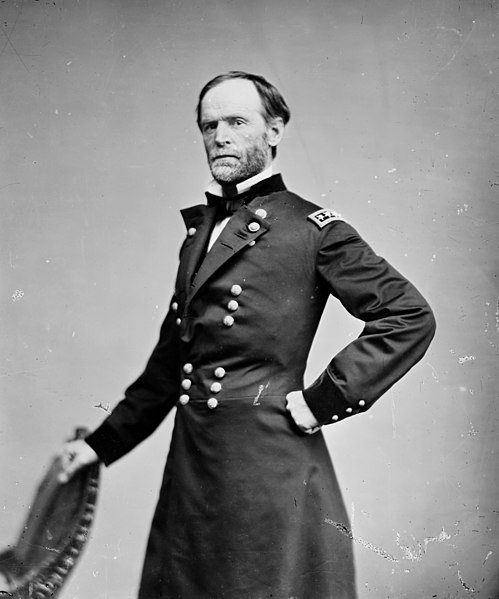
William Tecumseh Sherman was an American who served as a soldier, businessman, teacher, and author from February 8, 1820 until his death on February 14, 1891.
During the American Civil War (1861-1865), he served as a Union commander and earned both and criticism for his brutal scorched-earth policies for the Confederate States. History scholar and military theorist B. H. Liddell Hart of Britain called Sherman “the first modern general.”
Sherman, born into a strong political family in Ohio, enrolled in and graduated from West Point in 1840. In 1853, he left the army to pursue a career in private industry, but he failed.
In 1859, he was named superintendent of what is now Louisiana State University but was then called the Louisiana State Seminary of Learning and Military Academy.
Sherman fought in the First Battle of Bull Run as the commander of a brigade of volunteers in 1861. Although he was stationed in Kentucky, his pessimistic attitude on the war’s fate caused a psychological breakdown that required medical leave.
He sought solace in General Ulysses S. Grant and their alliance helped him get better. Sherman fought alongside Grant in the engagements of Fort Henry and Fort Donelson, Shiloh, the operations that led to the fall of the Confederate stronghold of Vicksburg on the Mississippi River, and the Chattanooga campaign, which resulted in the routing of Confederate armies in Tennessee.
Sherman took over the Union’s Western Theater after Grant was killed in 1864. He played a crucial role in the military victory that secured President Lincoln’s reelection: the capture of Atlanta.
Then, in an effort to weaken the Confederacy, Sherman marched into Georgia and the Carolinas, where he took part in only limited combat while laying huge havoc on cotton crops and other infrastructure.
In April 1865, Sherman accepted the surrender of Confederate forces in the Carolinas, Georgia, and Florida; nevertheless, the terms he negotiated were deemed unduly liberal by United States Secretary of War Edwin Stanton, who subsequently requested that General Grant revise them.
Sherman succeeded Grant as Army chief of staff after Grant was elected president in March 1869. Sherman commanded the American army throughout the Indian Wars from 1869 until 1883.
In 1875, he wrote his memoirs, which became one of the most well-known first-hand accounts of the Civil War, and he steadfastly avoided getting involved in partisan politics.
4. Joseph Hooker
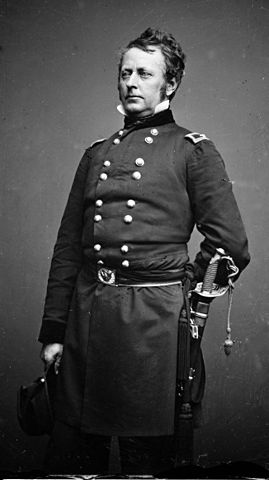
In 1863, Union commander Joseph Hooker (November 13, 1814 – October 31, 1879) was defeated by Robert E. Lee and the Confederates in the Battle of Chancellorsville.
Hooker served with distinction in the Army during the Seminole Wars and the Mexican-American War, gaining three brevet promotions before retiring.
At the outbreak of the Civil War, he enlisted in the Union army as a brigadier general and quickly rose through the ranks, becoming head of the Union Army’s Potomac Division after decisive victories at Williamsburg, Antietam, and Fredericksburg.
Due to Lee’s tactics, which separated his army and routed a Union corps, the inexperience of his subordinate generals, and Hooker’s own lack of nerve, Hooker’s grand strategy for Chancellorsville was a failure. After the initial setback, though, Lee recovered and made his way north to Gettysburg.
While General Halleck and President Lincoln declined Hooker’s plea for reinforcements, Hooker resigned from his position as commander. George G. Meade was elevated to command the Army of the Potomac just three days before the start of the Battle of Gettysburg.
After leaving the battlefield in protest before the end of the Atlanta Campaign because he was passed over for promotion, Hooker returned to the battlefield in November 1863 to aid in the relief of the besieged Union Army at Chattanooga, Tennessee, and to continue in the Western Theater under Maj. Gen. William T. Sherman.
An unfortunate journalistic typo resulted in Hooker being known as “Fighting Joe,” and the moniker stuck. He himself had a reputation as a heavy drinker and ladies’ man, and his workplaces were known for their many parties and gambling.
5. Winfield Scott Hancock
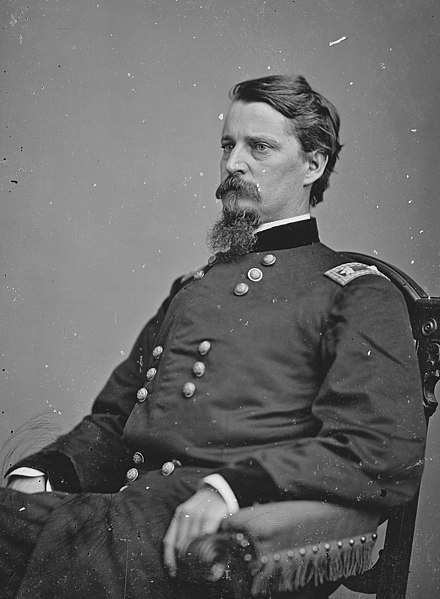
Democratic presidential candidate and U.S. Army officer Winfield Scott Hancock ran in 1880. (February 14, 1824 – February 9, 1886).
For four decades, he served in the military, but his most notable duties came as a Union general in the American Civil War and the Mexican-American War. Because of his outstanding leadership during the Battle of Gettysburg in 1863, he became known as “Hancock the Superb” among his fellow soldiers.
After the war ended, Hancock remained in the military, taking part in both the military’s Reconstruction efforts in the South and its border patrols along the West.
In light of his reputation as a Unionist and supporter of state’s rights as well as his status as a battle hero at Gettysburg, Hancock could have considered a bid for the presidency.
In 1880, as the Democratic contender for president, he and James A. Garfield, the Republican candidate, fought to a very close finish. President Ulysses S. Grant’s burial procession in 1885, led by Hancock.
6. George Henry Thomas
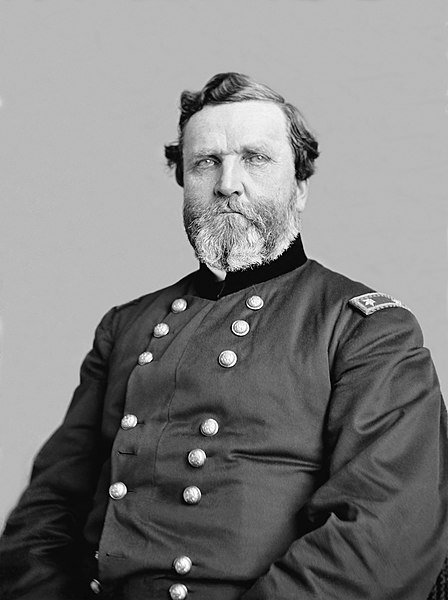
George Henry Thomas (July 31, 1816–March 28, 1870) was a prominent Union Army general in the Western Theater of the American Civil War.
Thomas, who had family roots in Virginia, fought as a Union soldier in the South and stayed in the army after the war ended. Prior to this, he had served in the Mexican-American War (whose home state would join the Confederate States of America).
One of the earliest Union victories of the war was at Mill Springs, Kentucky, under his command, and he went on to oversee important subordinate forces at Perryville and Stones River. He earned the nickname “the Rock of Chickamauga” in 1863 when his courageous defense prevented complete Union Army defeat.
During the Battle of Chattanooga, he made a brilliant advance up Missionary Ridge. One of the most significant triumphs of the war occurred in 1864 when he defeated the forces of Confederate General John Bell Hood, a former student of his at West Point, during the Franklin-Nashville Campaign.
When compared to his contemporaries Ulysses S. Grant and William T. Sherman, Thomas’s record in the Civil War is less well-known but no less impressive.
He was considered to be a cautious leader who would delay making decisions and would turn down promotions if he didn’t think they were deserved.
7. Winfield Scott

Winfield Scott, American political leader and general, was born on June 13, 1786 and passed away on May 29, 1866. In the years between 1814 and 1861, he served as a general in the United States Army, seeing action in the War of 1812, the Mexican-American War, the early stages of the American Civil War, and conflicts with Native Americans.
In 1852, Scott stood for president as a Whig candidate but ultimately lost to the Democratic nominee, Franklin Pierce. Due to his long career in the military, he was dubbed the Grand Old Man of the Army. Other names for him included Old Fuss and Feathers.
He retired and ended up living out his days in West Point, New York, where he died on May 29, 1866. Recent scholarship has established Scott’s place among the most accomplished American Civil War generals.
8. Ambrose Burnside

Ambrose Everett Burnside (May 23, 1824 – September 13, 1881) was a prominent American soldier and politician. He was a leading Union commander during the Civil War and was elected governor of Rhode Island three times. The manufacturing company he founded and maintained was quite successful, and he was the inventor of several practical items.
Due to his early successes in the Eastern Theater, he was promoted despite his lack of qualifications. His reputation, however, was permanently damaged by his defeats at Fredericksburg and the Battle of the Crater (Petersburg). Even though he was found not guilty in the second incident, he was never trusted again as a military leader.
Burnside was a modest man who was aware of his own shortcomings but was nevertheless forced into a position of authority.
It’s safe to say that misfortune followed him everywhere he went, from the battlefield (where he was killed) to the boardroom (where he was deprived of the revenues from a successful cavalry weapon he had created). In honor of his legendary beard growth, the name “sideburns” was invented.
9. Robert Anderson
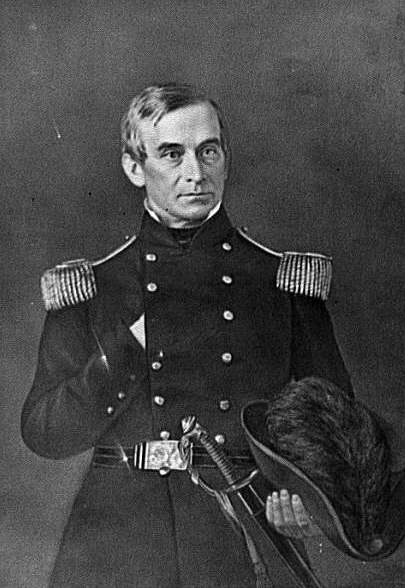
In the American Civil War, United States Army officer Robert Anderson (June 14, 1805 – October 26, 1871) played a key role.
In April 1861, when the Confederates began the American Civil War by bombarding Fort Sumter and forcing its surrender, he led the Union forces.
Anderson was granted command of Union forces in Kentucky and hailed as a hero in the North, where he was eventually elevated to brigadier general.
He was transferred to Rhode Island at the end of 1861 and eventually retired in 1863.
10. George Armstrong Custer
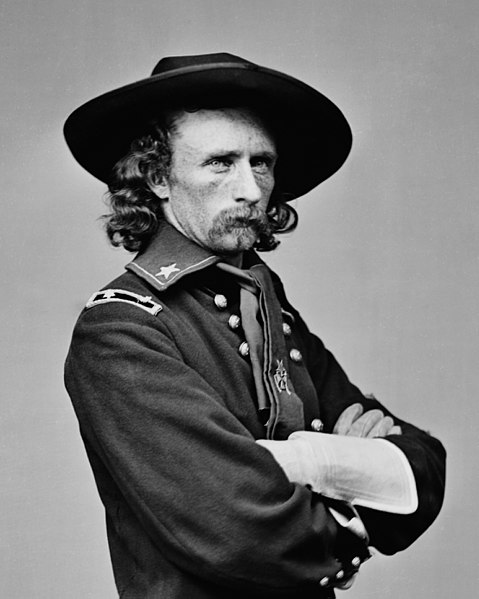
U.S. Army officer and cavalry leader during the American Civil War and the American Indian Wars, George Armstrong Custer (December 5, 1839 – June 25, 1876).
Custer may have been towards the bottom of his West Point class in 1861, but the need for skilled commanders was dire given the impending outbreak of the Civil War.
By the time he was 23, he had already risen to the rank of brigadier general of volunteers thanks to the praise of veterans like General George B. McClellan and the man who would become General Alfred Pleasonton.
A few handful of days after his promotion, he led the Michigan Cavalry Brigade to victory over J. E. B. Stuart’s outnumbered charge on what is now known as the East Cavalry Field during the Battle of Gettysburg.
In 1864, he participated in the Overland Campaign and was a part of Philip Sheridan’s army that defeated Jubal Early at Cedar Creek in the Shenandoah Valley. When the Army of Northern Virginia tried to make its final retreat, his division was there to stop them and was the first to receive a truce flag from the Confederates.
